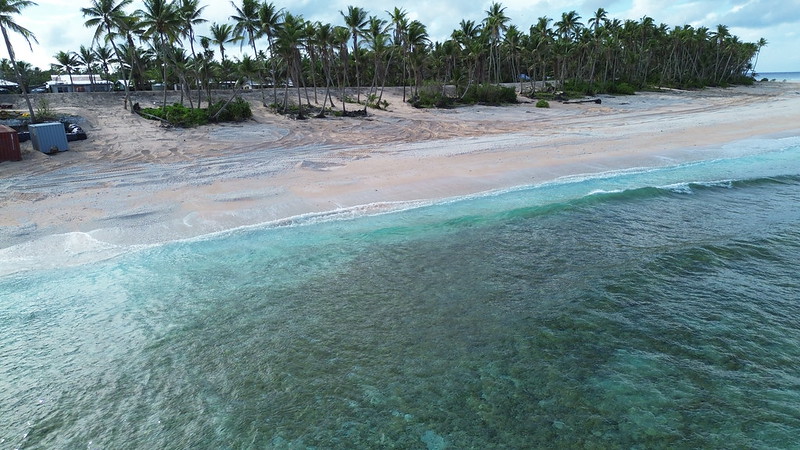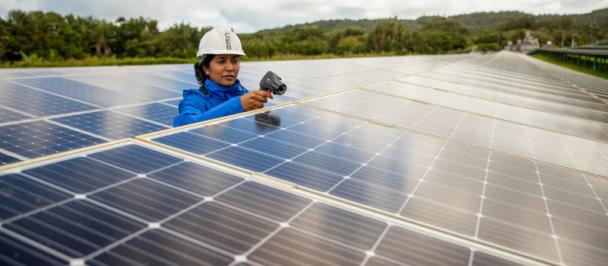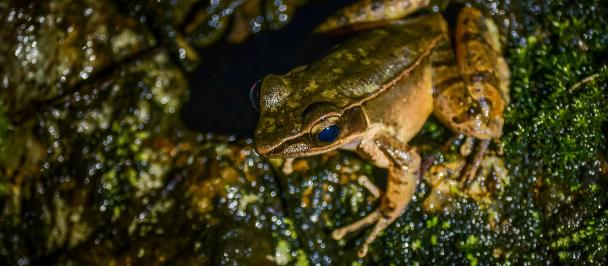Navigating the future of atoll nations
May 31, 2024

In Tuvalu, a coastal hazard monitoring tool supports early warning systems and disaster response.
In her homeland, the Maldives, Sazna Abdul Rasheed is excited. Despite the sweltering heat during the hottest time of the year, she has word, via a newly upgraded weather app, that an abundance of rainwater is on the way. This is part of a joint effort from UNDP and the Green Climate Fund to support communities to manage climate change-induced water shortages.
Cleaning out her roof with a broom crafted from coconut leaves, Sazna uses a traditional method of rainwater collection: diverting rainwater from her roof into large household tanks. Now, she can quickly clean her roof early before the rain comes, whereas in the recent past, it has not been easy to predict how much rain would fall, or when.
Combining traditional coping mechanisms with weather forecasting capabilities can help build resilience among communities where previous forecasting tools are no longer fit-for-purpose due to weather changes. Especially when they are implemented together with support for informed decision-making, incorporating climate risks into local development planning is essential.
As one of millions facing water shortages across Small Island Developing States (SIDS), the integrated water system provides uninterrupted water supplies during droughts. Based on improving ground-water quality in the long-term - alongside management of rainwater and desalinated water - annual water shortages have become a thing of the past.
Small islands, big potential
SIDS are on the frontlines of the climate crisis. Between 1970 and 2020, in aggregate, the 39 SIDS lost US$153 billion to climate and water-related hazards, a particularly daunting amount given that the average GDP for SIDS is US$13.7 billion.
But they are also spearheading solutions. Embracing the digital transformation, islands are tapping important digital insights, leveraging digital mapping, satellite imagery and remote sensing to build resilient infrastructure and mitigate inundation by ocean waves.
In Tuvalu, a coastal hazard monitoring tool was launched to support early warning systems and disaster response. For the first time, the online platform allowed the atoll nation to clearly identify, plan for, and reduce risks associated with sea level rise and more frequent storms driven by climate change, by monitoring shoreline changes and potential hazards. Such precise forecasts allow communities to prepare and potentially move important assets and property to safer locations.
In the Dominican Republic, UNDP and the Global Environment Facility are collaborating on early warning systems-based geospatial data, and capacity building to support improved forest fire management. Despite a rise in the number of fires in 2023, there has since been a decrease in impacted hectares, with future collaboration and research efforts needed to monitor biodiversity impacts alongside forest fire management.
Such solutions have the potential for change across SIDS and beyond, especially as SIDS territories comprise 20 percent of the world’s offshore exclusive economic zones. The Blue and Green Island Integrated Programme (BGI-IP), is financed by the Global Environment Facility. UNDP leads this initiative in five countries, including Comoros, Papua New Guinea, Samoa, the Seychelles and Timor-Leste.
Working across 15 countries, the initiative aims to reduce ecosystem degradation by scaling up nature-based solutions to restore ecosystems, conserve biodiversity, and enable sustainable livelihoods. It includes a marine spatial plan in Papua New Guinea to protect marine diversity; rehabilitating degraded landscapes in the Seychelles and restoring over-exploited marine fisheries in Timor-Leste to more sustainable levels.
Under the same initiative, in the Comoros, efforts to strike a balance between tourism, food and urban challenges, will connect rural and urban communities to produce and commercialize natural products sourced from national parks like black peppers, aromatic chili peppers, and mangrove crabs. The initiative will be implemented across six national parks and three cities, with a knowledge sharing approach supporting collective scaling across the Comoros.

The Blue and Green Island Integrated Programme works in 15 countries, to reduce ecosystem degradation, conserve biodiversity, and enable sustainable livelihoods.
“BGI-IP is exciting because the participating SIDS have the potential to become incubators for innovation and nature-based solutions that can be scaled across the SIDS and beyond. We have the opportunity to show what SIDS can achieve as large ocean states.”Midori Paxton, UNDP Nature Hub Director

Between 1970 and 2020 the 39 SIDS lost US$153 billion to climate and water-related hazards.
UNDP is supporting Tonga to safeguard endemic and globally threatened wetland biodiversity, while addressing watershed degradation, unsustainable marine resource exploitation, and the impacts of invasive alien species. Over the past decade, similar 'Ridge to Reef' approaches have been and continue to be implemented across 13 SIDS countries, including Tonga, Grenada, the Cook Islands, Haiti, Fiji, Nauru, Micronesia, Papua New Guinea, Tuvalu, Niue, the Marshall Islands, St Vincent and Grenadines, and the Seychelles. This is improving the management of 190 million hectares of marine ecosystems.
“Where wealth owners are either inadequately informed about opportunities in the global south, where their money can be invested sustainably and profitably, or the finance architecture disadvantages some jurisdictions see as too risky an investment, there is a need to drive the impact investment narrative. There are clear opportunities to invest in sectors such as sustainable agriculture, renewable energy, conservation, and basic services such as housing, healthcare, and education. This approach, however, requires consensus among stakeholders who own, manage, host, and trade capital.”– Amanda K Serumaga, UNDP Resident Representative, Mauritius and Seychelles
Seychelles was once almost entirely dependent on imported oil to meet its energy needs, including electricity production. Joint efforts from UNDP and the GEF were designed to support the country in transforming an energy sector that relied on imported fossil fuels into one where solar photovoltaics (PV) and other renewable energy sources provide a significant percentage of national energy production going forward.
Before the initiative, the country only had three small PV on-grid installations with a total capacity of 10-kilowatt peak – enough to power roughly one home. UNDP and GEF efforts supported the installation of 181 new PV systems as of 2016, with a combined installed capacity of 1.79 megawatts. Based on the average household electricity consumption in Seychelles, the new PV systems can power around 900 homes.
As the interconnections between nature and people’s livelihoods and well-being are particularly obvious in SIDS, such initiatives aim to , and increase income while also protecting the planet. UNDP’s long-term interventions support countries and partners to deliver consistent results over time, mobilizing capital where it is needed most. And, to support SIDS in rising above their collective challenges: from water shortages – such as those faced by Sazna – to broader, nation-wide dependence on imported fuels, such as in the Seychelles.

 Locations
Locations



